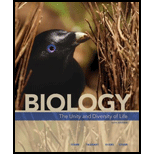
Bioaccumlation in tuna Bluefin tuna are among the fishes that were exposed to radioactive material released into the sea by the damaged Fukushima nuclear power plant (Section 47.1). These tuna breed in the western Pacific, and some migrate to the Eastern Pacific when they are 1 to 2 years old. Daniel Madigan suspected that migrating tuna would transport radioactive material to the waters off the coast of California. To test this hypothesis, he and his collaborators analyzed the concentration of cesium radioisotopes (137Cs and 134Cs) in bluefin tuna and yellowfin tuna caught near San Diego in August 2011. Yellowfin tuna do not cross the Pacific; they spend their lives in California's coastal waters. The scientists compared these data with the radioisotope content of bluefin tuna that had been caught near San Diego in 2008. FIGURE 48.9 shows their results.

FIGURE 48.9 Radioactive cesium (Cs) concentration in two species of tuna caught along the coast of California.
137Cs has a half-life of 30 years and some persists in the Pacific from weapons testing. 134Cs has a half-life of 2 years and was undetectable in the Pacific prior to the accident at Fukushima. Becquerels (Bq) is a measure of radioactivity.
How did the radioisotope content of the bluefin tuna caught in August of 2011 compare to that of bluefins caught in 2008 (before the Fukushima accident)?
To determine: How the radioactive content of the bluefin tuna caught in August of 2011 compare to that of bluefins caught in 2008 (before the Fukushima accident).
Concept introduction: Bioaccumulation is the concentration of a pollutant inside an organism’s tissues causing the amount of the pollutants to increase over time. Trophic level also affects the pollutant concentration by the process of biological magnification The concentration of the chemical increases as the pollutant moves up the food chain. Bioaccumulation and biological magnification even in low concentrations (depending on toxic potential) can have detrimental effects on a species.
Explanation of Solution
The powerful earthquake occurred in the northeast coast of Japan in March 2011 caused tsunami that killed 15,000 people. During this time, the nuclear power plant on the shore of the city Fukushima became damaged and released some radioactive materials into the air and sea. The water was polluted with cesium 137 (137Cs), a radioactive material having a half-life of 30 years.
The bluefin tuna are among the fishes that were exposed to radioactive materials released into the sea. These tuna fishes breed in the western Pacific and some migrate to the Eastern Pacific when they are 1 to 2 years old. Researcher D suspected that the tuna might have transported the radioactive material off the coast of California. To test this hypothesis, the concentration of cesium radioisotopes (137Cs and 134Cs) in bluefin tuna and yellowfin tuna caught near the San Diego in August 2011were analyzed for the presence of cesium.
The yellowfin tuna reside in the California’s coastal water and they do not cross the Pacific. Therefore, the presence of cesium in yellowfin tuna was compared with bluefin tuna.
Refer to Fig. 48.9, “Radioactive (Cs) concentration in two species of tuna caught along the coast of California” in the question. From the figure, the bluefin tuna caught in 2011 have 6.3 Bq and 4 Bq of 137Cs and 134Cs, respectively; whereas the bluefin tuna caught in 2008 have 1.4 Bq and 0 Bq of 137Cs and 134Cs, respectively.
Therefore, the bluefin tuna caught after the Fukushima nuclear plant incident (2011) have a higher level of cesium radioactivity than the bluefin tuna caught before the incident (2008).
134Cs radioisotope and a lower level of 137Cs were found in the bluefin tuna caught in 2008; however, the tuna caught after the accident in 2011 contained a higher level of both radioisotopes.
Want to see more full solutions like this?
Chapter 48 Solutions
Biology: The Unity and Diversity of Life (MindTap Course List)
Additional Science Textbook Solutions
Biological Science (6th Edition)
College Physics: A Strategic Approach (3rd Edition)
Laboratory Manual For Human Anatomy & Physiology
SEELEY'S ANATOMY+PHYSIOLOGY
Biology: Life on Earth with Physiology (11th Edition)
- What is behavioral adaptarrow_forward22. Which of the following mutant proteins is expected to have a dominant negative effect when over- expressed in normal cells? a. mutant PI3-kinase that lacks the SH2 domain but retains the kinase function b. mutant Grb2 protein that cannot bind to RTK c. mutant RTK that lacks the extracellular domain d. mutant PDK that has the PH domain but lost the kinase function e. all of the abovearrow_forwardWhat is the label ?arrow_forward
- Can you described the image? Can you explain the question as well their answer and how to get to an answer to an problem like this?arrow_forwardglg 112 mid unit assignment Identifying melting processesarrow_forwardGive only the mode of inheritance consistent with all three pedigrees and only two reasons that support this, nothing more, (it shouldn't take too long)arrow_forward
- Oarrow_forwardDescribe the principle of homeostasis.arrow_forwardExplain how the hormones of the glands listed below travel around the body to target organs and tissues : Pituitary gland Hypothalamus Thyroid Parathyroid Adrenal Pineal Pancreas(islets of langerhans) Gonads (testes and ovaries) Placentaarrow_forward
 Biology Today and Tomorrow without Physiology (Mi...BiologyISBN:9781305117396Author:Cecie Starr, Christine Evers, Lisa StarrPublisher:Cengage Learning
Biology Today and Tomorrow without Physiology (Mi...BiologyISBN:9781305117396Author:Cecie Starr, Christine Evers, Lisa StarrPublisher:Cengage Learning Biology 2eBiologyISBN:9781947172517Author:Matthew Douglas, Jung Choi, Mary Ann ClarkPublisher:OpenStax
Biology 2eBiologyISBN:9781947172517Author:Matthew Douglas, Jung Choi, Mary Ann ClarkPublisher:OpenStax Biology: The Dynamic Science (MindTap Course List)BiologyISBN:9781305389892Author:Peter J. Russell, Paul E. Hertz, Beverly McMillanPublisher:Cengage Learning
Biology: The Dynamic Science (MindTap Course List)BiologyISBN:9781305389892Author:Peter J. Russell, Paul E. Hertz, Beverly McMillanPublisher:Cengage Learning Concepts of BiologyBiologyISBN:9781938168116Author:Samantha Fowler, Rebecca Roush, James WisePublisher:OpenStax College
Concepts of BiologyBiologyISBN:9781938168116Author:Samantha Fowler, Rebecca Roush, James WisePublisher:OpenStax College Human Biology (MindTap Course List)BiologyISBN:9781305112100Author:Cecie Starr, Beverly McMillanPublisher:Cengage Learning
Human Biology (MindTap Course List)BiologyISBN:9781305112100Author:Cecie Starr, Beverly McMillanPublisher:Cengage Learning Biology: The Unity and Diversity of Life (MindTap...BiologyISBN:9781337408332Author:Cecie Starr, Ralph Taggart, Christine Evers, Lisa StarrPublisher:Cengage Learning
Biology: The Unity and Diversity of Life (MindTap...BiologyISBN:9781337408332Author:Cecie Starr, Ralph Taggart, Christine Evers, Lisa StarrPublisher:Cengage Learning





